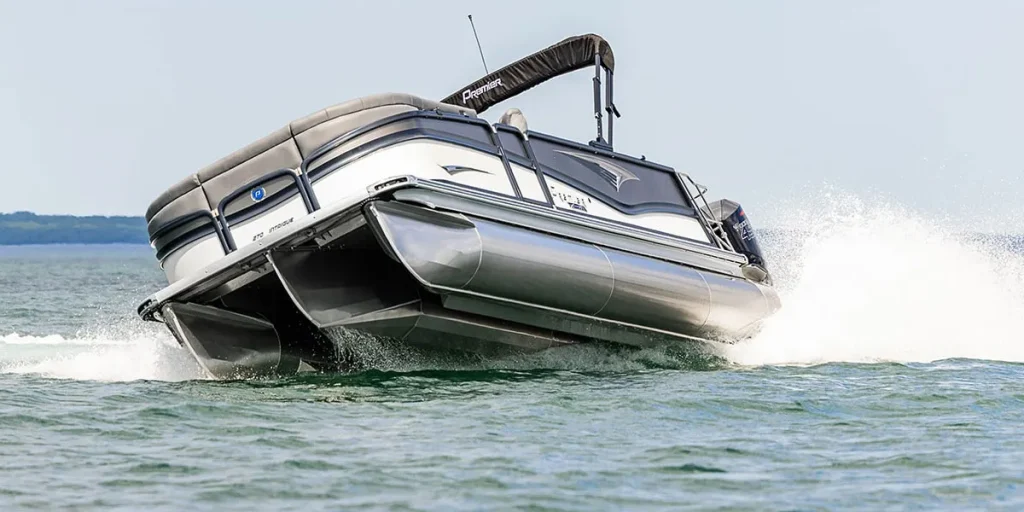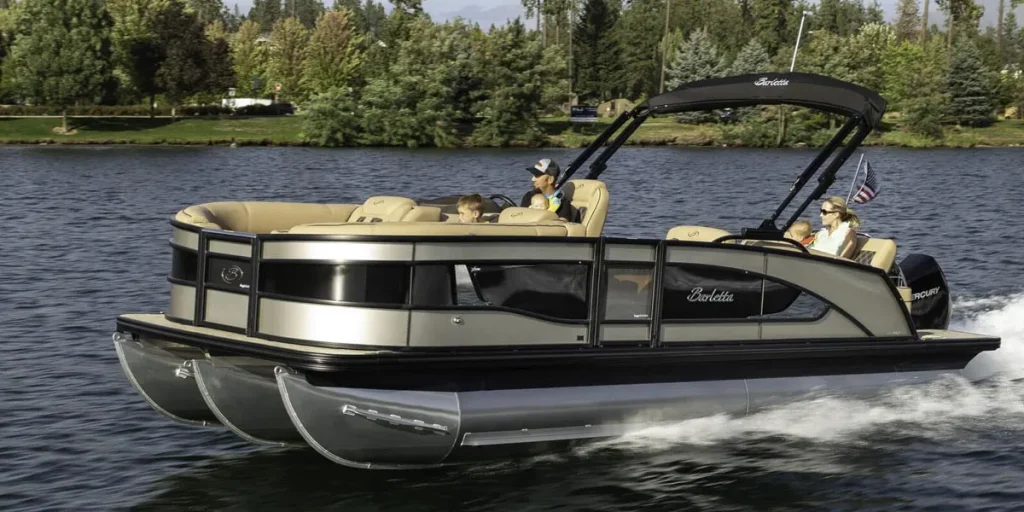A standard tritoon typically weighs between 2,200 and 3,200 pounds. This weight does not include the motor or any gear and accessories.
Owning a tritoon, a pontoon boat with three aluminum tubes instead of two, is becoming increasingly popular for recreational boating.
These versatile crafts are ideal for a variety of activities, from peaceful fishing trips to thrilling water sports.
The added buoyancy of the third tube allows for more passenger capacity, enhanced stability, and the potential for larger, more powerful engines.
When evaluating the different tritoon options, one should consider the weight of the vessel as it impacts trailering, storage, and performance.
Choosing the right tritoon involves balancing size, weight, and engine capacity to match your boating needs and ensure a safe, enjoyable experience on the water.
Basics Of Tritoon Boats
Tritoon boats bring more stability and capacity to the waterways. Three aluminum tubes provide the backbone for these vessels.
Unlike their pontoon counterparts, tritoons boast a heftier build. This design offers more control and smoother handling on various bodies of water.
Tritoon Versus Pontoon: Core Differences
Understanding the differences between a tritoon and a pontoon boat is essential.
Tritoons feature an extra tube, ensuring better buoyancy and stability.
They handle higher power engines well and deliver superior performance. Tritoons glide effortlessly, even through choppy conditions.
Materials And Construction Impact On Weight
The materials and construction of a tritoon greatly influence its weight. Aluminum is the primary material, known for its lightweight yet sturdy properties.
The addition of the third tube typically adds more weight compared to pontoons.
Here’s a quick guide:
- Aluminum tubes: Light but robust
- Deck construction: Often includes marine-grade plywood or composite
- Added features: Furniture, helm, and amenities contribute to overall weight
The average tritoon boat weight ranges between 2,000 and 5,000 pounds, sans the engine.
Material choices and add-ons can push the scale upwards, essential to note for towing and capacity purposes.
Weight Factors Of Tritoons

Understanding how much a tritoon weighs is crucial when considering a purchase. A tritoon’s weight impacts transportation, performance, and storage.
Various factors influence its overall weight. Let’s delve into what affects the weight of these popular watercraft.
Size And Dimension Variances
Tritoons come in different lengths and widths. Larger tritoons will generally weigh more due to the added material and structure needed for increased size.
Below is a simple breakdown of how size impacts weight:
- Length: Ranges from 20 to 28+ feet.
- Width: Influences stability and capacity.
- Material: Heavier or lighter depending on construction.
These variances are pivotal in determining the final weight and should be carefully considered when looking at tritoon options.
Influence Of Engine And Equipment
The engine is a significant contributor to a tritoon’s weight. Larger, more powerful engines equal a heavier craft. Here’s a list of standard equipment that can affect weight:
| Equipment | Weight Influence |
|---|---|
| Engine | Adds substantial weight |
| Furniture | Varies by quantity and materials |
| Accessories | Influences overall weight |
Average Weight Range
The weight of a tritoon can impact its performance, capacity, and transportation needs. Understanding the average weight range helps prospective owners prepare for handling and maintenance.
Tritoons, with their three hulls, generally weigh more than their pontoon counterparts. This weight varies greatly from smaller models to large luxury editions.
Small To Medium Tritoons
The weight of small to medium tritoons can vary. On average, these vessels typically range from:
- 2,000 to 2,500 pounds for the smaller tritoons
- 3,000 to 3,500 pounds for medium-sized models
These weights are for the tritoon alone, without any gear or people.
Large And Luxury Models
Larger tritoons, especially those equipped with high-end amenities, are heavier. Owners often encounter weights like:
- 3,500 to 4,500 pounds for large tritoons
- Over 5,000 pounds for luxury models with full gear
These models may also require more powerful engines, increasing total weight.
Remember, the total weight affects trailering and fuel consumption. Choose the right tritoon by considering its dry weight and maximum capacity.
Impact Of Weight On Performance And Transportation

The weight of a tritoon boat affects its performance and how you move it around. Heavier boats might go slower but can offer a smoother ride.
Lighter boats can be faster but might be trickier to handle. The weight will also decide what kind of vehicle you’ll need to tow your tritoon.
Speed
The weight of a tritoon influences its speed. More weight can make the boat slower. Engines work harder to push heavy boats through water.
Light tritoons get up to speed faster than heavy ones.
Stability And Handling
A well-weighted tritoon stays more stable on the water. This means it won’t rock around too much.
Its handling gets more predictable too. Stability helps in strong waves or when making sharp turns.
- Reduced rocking means a smoother ride.
- Heavier tritoons handle better in choppy conditions.
- Weight affects balance, which changes how the boat steers.
Towing Requirements For Tritoons
To move your tritoon, you need the right towing setup. The weight decides what kind of vehicle you need. The right towing gear keeps the boat safe on the road.
| Boat Weight | Towing Vehicle |
|---|---|
| <2,500 lbs> | Regular Car/SUV |
| <3,500 – 5,000 lbs> | Large SUV/Truck |
| >5,000 lbs | Heavy-duty Truck |
Plan ahead. Know your tritoon’s weight. Pick the right vehicle to tow it safely. Ensure you stay within your tow vehicle’s limits. This helps prevent damage and accidents on the road.
Real-world Examples
When choosing a tritoon, its weight is crucial. It affects trailering, performance, and capacity. Here we dive into actual examples to understand tritoon weights better.
Comparing Popular Tritoon Brands
Let’s explore different tritoon brands and their weights:
- Manitou: Known for luxury and performance, these tritoons range between 2,000-3,850 pounds.
- Bennington: Offering a variety of styles, these boats weigh between 2,500-3,900 pounds.
- Sun Tracker: Perfect for family outings, expect weights around 2,200-3,700 pounds.
- Harris: Combining elegance with durability, Harris models weigh in at 2,600-3,800 pounds.
This data helps gauge what to expect when comparing brands.
Case Studies: Weight And Its Practical Implications
Learn from real-life scenarios, showing how weight impacts use:
- Case Study 1: A Manitou X-Plode weighed 3,500 pounds. It required a larger vehicle to tow. The owner noticed smoother rides in rough waters due to the weight.
- Case Study 2: A Bennington S Series at 3,000 pounds had a mid-sized SUV as its companion for transport. Its lighter frame offered remarkable fuel efficiency.
These examples depict how weight plays a role in overall boating experiences.
Maintenance Considerations Related To Weight
Understanding how much a tritoon weighs is vital for maintenance. Heavier boats may need special care. Regular maintenance helps your tritoon last longer and perform better.
Winterizing And Storage Challenges
Tritoons, with their significant weight, present unique challenges during off-season storage. Due to their heft, proper winterization is critical.
A tritoon typically weighs between 2,000 to 5,000 pounds. When winterizing:
- Drain all water from the engine and plumbing.
- Use antifreeze designed for marine engines.
- Clean the tritoon to prevent corrosion and damage.
Storage solutions, such as lifts or trailers, must be capable of handling your tritoon’s weight. Factor in the weight when considering:
| Storage Type | Weight Capacity |
|---|---|
| Lifts | Ensure it exceeds tritoon weight |
| Trailers | Match or surpass the tritoon’s weight |
Lifespan And Durability
A tritoon’s weight impacts its lifespan and durability. Heavy boats require stronger materials. Here are key maintenance tasks for longevity:
- Inspect the pontoons for leaks or damage regularly.
- Check the weight distribution to avoid pressure on the structure.
- Use quality cleaning products to maintain the hull.
Heavier tritoons can put more stress on their components. It’s crucial to follow a regular maintenance schedule. Proper care ensures your tritoon withstands the test of time.
FAQs About the Weight of a Tritoon
What Is The Average Weight Of A Tritoon?
Tritoons typically average around 3,000 to 5,000 pounds without passengers or gear.
Specific weight can vary based on size and amenities.
Does The Weight Of A Tritoon Affect Its Performance?
Yes, the weight of a tritoon affects its performance. Heavier tritoons may require more powerful engines and can be less agile, but often offer smoother rides.
How Does Engine Weight Impact Tritoon Total Weight?
Engine weight significantly contributes to a tritoon’s total weight. Larger engines can weigh over 500 pounds, influencing the overall weight and performance of the vessel.
Can The Weight Of A Tritoon Vary By Brand?
Tritoon weight does vary by brand and model. Different manufacturing materials and included features can cause weights to range quite substantially between brands.
Conclusion
Understanding the weight of a tritoon is crucial for safe operation and transport. With averages ranging between 2,000 to 5,000 pounds, your specific model’s specifications are key.
Always consult your manual for exact figures, ensuring a seamless boating experience. Remember, safety and preparedness go hand-in-hand with enjoying the water.
Resources:
https://www.maine.gov/ifw/fishing-boating/boating/index.html
https://www.boatersworld.com/blog/what-is-a-tritoon-boat-and-how-is-it-different-from-pontoon–61584
